Liberty Eagle coins

 $10 Liberty Gold Eagles - minted with and without motto
$10 Liberty Gold Eagles - minted with and without motto
Close to 43 million Liberty Eagle coins were minted by the US Mint at its facilities in Philadelphia, New Orleans, San Francisco, Carson City and Denver from 1838 to 1907. Proof $10 Eagles are very rare gold coins though since only a very small amount of proof coins were minted at the Philadelphia facility (only 1 proof coin was minted elsewhere, in New Orleans in 1844). The $10 Liberty Gold Eagles were succeeded by the $10 Indian Gold Eagles in 1907.
The $10 Eagles were made of 90% gold and 10% copper with each coin containing 0.48375 oz of gold. The obverse side of the coins shows a leftward facing Lady Liberty in profile. An eagle that is holding a shield can be seen on the reverse. These are both common images that appear in some form on many other pre-1933 U.S. gold coins as well.
If you want to buy gold in the form of $10 Liberty Gold Eagle coins, you should know that there exist some coin variations. Most importantly, Liberty Eagle gold coins were minted both with and without the motto "In God We Trust". It was only added to the reverse design in 1866. American buyers that are investing in gold for their retirement should take note that the coins are not eligible for inclusion in Individual Retirement Accounts (IRA's) since they are classified as collectible gold coins by the IRS.
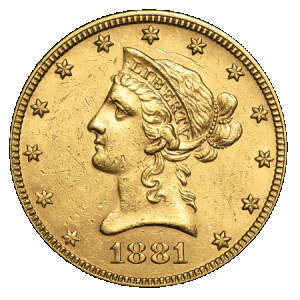
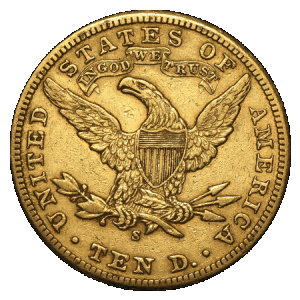
Coin Fact Sheet
| Weight | Face Value | Purity | Diameter |
|---|---|---|---|
| 0.48375 oz | US $ 10 | 90% | 27 mm |
Total Mintage: 42,684,236
Liberty Eagle Coin Design
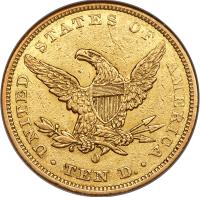
The obverse side of each $10 Liberty Gold Eagle depicts a leftward facing Lady Liberty in profile in the style of Greco-Roman sculptures. She wears a pearl crown that has "Liberty" inscribed on it. Thirteen stars appear along the outer edge of the coin, representing the 13 original colonies of the United States of America. The year of mintage is inscribed underneath Lady Liberty's portrait.
The motif on the reverse side of the Liberty Gold Eagles is derived from the Great Seal of the United States. It shows an eagle with a shield holding an olive branch and arrows. The motto "IN GOD WE TRUST" appears on a banner above the eagle on coins minted from 1866 onwards. The image at the top of the page shows a coin from 1881 that has the motto on its reverse.
The coin's $10 face value (TEN D.) and “UNITED STATES OF AMERICA” are engraved along the coin's edge. Liberty Head Gold Eagles that were minted in New Orleans (mintmark: O), San Francisco (mintmark: S), Carson City (mintmark: CC) or Denver (mintmark: D) contain a mintmark just above the face value and underneath the eagle's claws. However, coins that were minted at the main Philadelphia branch of the United States Mint don't have any mintmark.
History of the $10 Liberty Gold Eagle
As a result of the Coinage Act of 1792, many gold coins were subsequently produced by the US Mint. The $10 Liberty Head Gold Eagle was one of them, even though it was not minted until 1838. The Liberty Head design that was created by the US Mint's engraver Christian Gobrecht appears on many other gold coins that were minted during this period.
In 1866, the motto "IN GOD WE TRUST" was added to the reverse side of the coin. The $10 Liberty Gold Eagle therefore exists with (1866 - 1907) and without motto (1838 - 1866).
The $10 Liberty Eagle coin was replaced by the $10 Indian Gold Eagle in 1907.
Even though production of the Liberty Eagle gold coin lasted from 1838 to 1907, only the US Mint in Philadelphia produced this type of coin in every year during this period.
Coin Variations
Coins that were minted in Philadelphia in 1842 and 1850 as well as in New Orleans in 1854 exist with both small and large date engravings.
Coins that were minted in San Francisco in 1866 exist both with and without the motto "IN GOD WE TRUST".
Rare Dates
Especially hard to find are the Liberty Eagle coins that were minted in Carson City in 1870 (mintage of 5,908 coins), 1872 (4,600 coins), 1873 (4,543 coins), 1875 (7,715 coins), 1878 (3,244 coins) and 1879 (1,762 coins).
The $10 Liberty Gold Eagles that were minted in Philadelphia are hard to find for the years 1858 (2,521 coins), 1863 (1,218 coins), 1873 (800 coins) and 1875 (100 coins). Proof coins are even harder to find if at all possible.
The coins minted in New Orleans are rare for 1859 (2,300 coins) and 1883 (800 coins) and the coins minted in San Francisco are rare for 1864 (2,500 coins).
Mintage Numbers
Annual mintage of the Liberty Head version of the $10 Eagle coin at the various US Mint branches varied between 100 coins (Philadelphia 1875) and 3,877,220 coins (Philadelphia 1881). Proof coins were almost exclusively minted at the Philadelphia branch of the US Mint and proof mintage varied between 1 coin and 120 coins (1900).
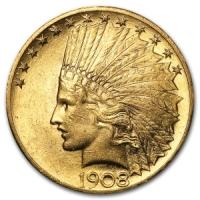
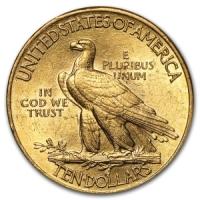
Indian Gold Eagles
The $10 Indian Gold Eagles succeeded the $10 Liberty Gold Eagles. The US Mint produced the new coins with years of interruption from 1907 to 1933. The coins were struck at the US Mint facilities in Philadelphia, San Francisco and Denver. They are composed of 90% gold and 10% copper with each coin containing 0.48375 oz of gold. Close to 15 million Indian Head Gold Eagles were minted. However, only a tiny amount were minted in proof condition at the Philadelphia facility. The coins depict a leftward facing Lady Liberty wearing a Native American headdress on the obverse and an eagle standing on a bundle of arrows with an olive branch on the reverse.
The Indian Gold Eagle page gives more information about the coins and allows you to compare current prices.